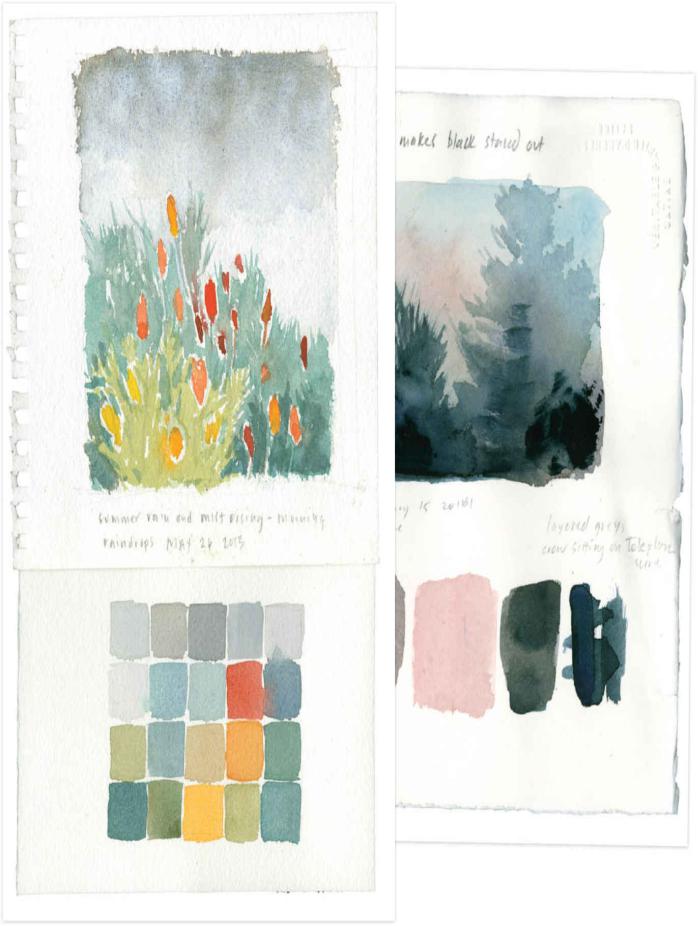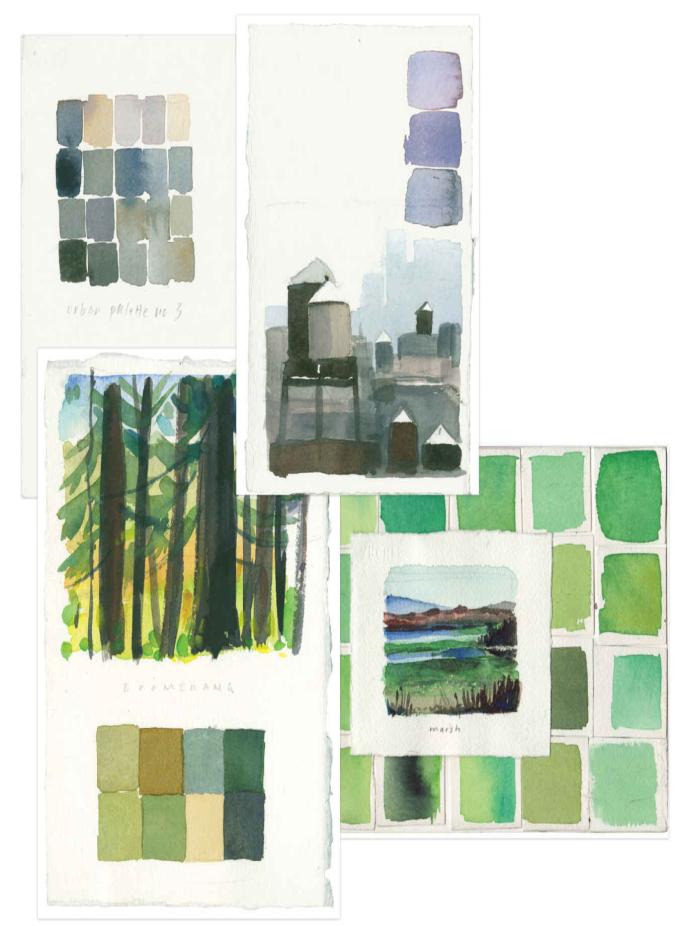
- •Acknowledgments
- •Introduction
- •Landscape
- •Ocean/Sky
- •Light
- •Wildflowers
- •Fog, Mist, and Haze
- •Forest, Lichen, and Moss
- •The Colors of Point Reyes National Seashore
- •Materials
- •Essential Equipment
- •Optional Equipment
- •Preparation
- •Paper Size & Grid
- •Pigments & Color Theory
- •Technique
- •Brush Marks
- •Painting
- •A Note on the Photographs
- •Habitat
- •Light
- •Weather
- •Seasons
- •Seasons: A Year in Color
- •Antigua, Guatemala
- •Lake Atitlán, Guatemala
- •Pátzcuaro, Mexico
- •Luxor, Egypt
- •The Dead Sea, Jordan
- •Petra, Jordan
- •Lake Issyk-Kul, Kyrgyzstan
- •Newport, Pennsylvania
- •Barney’s Joy, Massachusetts
- •Sacred Valley, Peru
- •Dominica, West Indies
- •Isle of Skye, Scotland
- •Inverness, Scotland
- •Mitchell, Oregon
- •New York, New York
- •San Francisco, California
- •Portland, Oregon
- •Big Picture
- •Detail
- •Sky Patch
- •Terrain
- •Rocks
- •Water
- •Color Walk
- •Color Memory
- •Naming Colors
- •Color Mixing
- •Primary and Secondary Colors
- •Tertiary Colors
- •Analogous Colors
- •Complementary Colors
- •Value or Tone
- •Color Temperature
- •How Many Greens are there?
CHAPTER THREE
Look Around You: Elements of Place
The practices in this book open the door to looking at color, engaging with it, and experimenting as you go. This is about a process. Have fun with these practices and jump in!
Here’s what I do in the field. I sit down and tune into my senses—sight, sound, touch. I may close my eyes, then open them again and take in the view, finding something I like. I look at one color and try to match it with paint, trying out color mixes on test paper. When I’m satisfied, I put that color down on my palette.
Focus on the elements of place: habitat, light, weather, and season. They will help ground you to wherever you are. They are all interconnected and influence one another in unique ways depending on the time of day or within a season.
Pick a color and try to match it. If the first mark doesn’t look quite right, keep mixing, making it warmer or cooler, darker or lighter, adjusting the color until you find what you want, then put that one down on the palette as well and move on to the next color you see. Once you’ve made your mark, resist the temptation to go over it and you’ll have cleaner colors.
Consider working on more than one color palette at a time. That way, the paint can dry on one while you shift your attention to another—perhaps another view or another set of colors from the same view.
A NOTE ON THE PHOTOGRAPHS
The photographs are here for reference, so you can see where my color palettes come from. I much prefer to work directly from nature. I sit and absorb a place. The color relationships between land, sky, water, weather conditions, quality of light, time of day, and the angle of the sun and shadows—all of these add up to fully experiencing your surroundings and being truthful to the moment.
HABITAT
Wherever you are—whether in a meadow or a city—you can observe and paint the colors of the local habitat. Habitat is just what you see around you: from sidewalk, floor, or path to buildings, trees, or mountains. The angle of the sun. The clouds in the sky. Each habitat is a collection of colors.



PRACTICE
•Bring your paints and find a comfortable place to sit. Take a moment and allow yourself to drop into this place. Close your eyes and open them—what colors do you see? Now look more closely. What are the colors beneath your feet? What are the colors at eye level? Overhead, do you see sky, tree branches, clouds, or the tops of high buildings? Notice the time of day and where the sun is in the sky. Can you see the moon? What is the season?
•Take your piece of paper and start with the color you see most of. What color sits next to that color? What color do you see traveling across a leaf or up the side of a building?
•Next, what color do you see least of? What proportion of the scene does each color take up? Notice how color takes on different forms—a version of gray may present itself as cloud, granite, or bark. Notice the feeling of the brush in your hand as it moves across the paper. As I am painting, I often think, “In through my eyes and out through my hand.”
•Shift your perspective. If you are sitting, do a color palette while standing; if you are standing, try one sitting. What differences do you see?
•Begin a color library of your local habitat, cataloging the spectrum of colors and how they change throughout the seasons.
